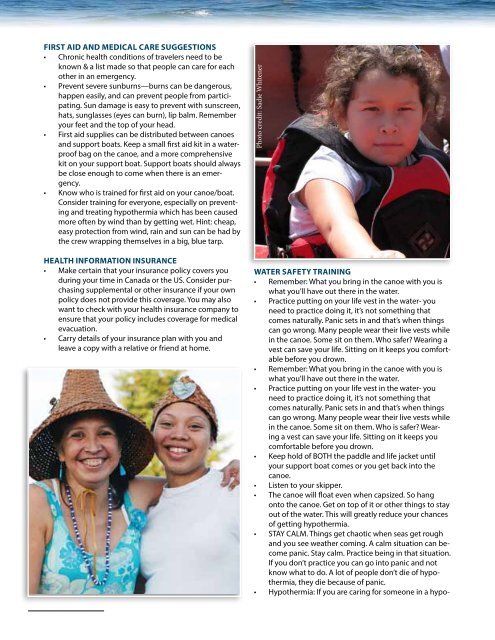Canoe Journey Guidebook - Squaxin Island Tribe
Canoe Journey Guidebook - Squaxin Island Tribe
Canoe Journey Guidebook - Squaxin Island Tribe
Create successful ePaper yourself
Turn your PDF publications into a flip-book with our unique Google optimized e-Paper software.
First Aid and Medical Care Suggestions<br />
• Chronic health conditions of travelers need to be<br />
known & a list made so that people can care for each<br />
other in an emergency.<br />
• Prevent severe sunburns—burns can be dangerous,<br />
happen easily, and can prevent people from participating.<br />
Sun damage is easy to prevent with sunscreen,<br />
hats, sunglasses (eyes can burn), lip balm. Remember<br />
your feet and the top of your head.<br />
• First aid supplies can be distributed between canoes<br />
and support boats. Keep a small first aid kit in a waterproof<br />
bag on the canoe, and a more comprehensive<br />
kit on your support boat. Support boats should always<br />
be close enough to come when there is an emergency.<br />
• Know who is trained for first aid on your canoe/boat.<br />
Consider training for everyone, especially on preventing<br />
and treating hypothermia which has been caused<br />
more often by wind than by getting wet. Hint: cheap,<br />
easy protection from wind, rain and sun can be had by<br />
the crew wrapping themselves in a big, blue tarp.<br />
Health Information Insurance<br />
• Make certain that your insurance policy covers you<br />
during your time in Canada or the US. Consider purchasing<br />
supplemental or other insurance if your own<br />
policy does not provide this coverage. You may also<br />
want to check with your health insurance company to<br />
ensure that your policy includes coverage for medical<br />
evacuation.<br />
• Carry details of your insurance plan with you and<br />
leave a copy with a relative or friend at home.<br />
Photo credit: Sadie Whitener<br />
Water Safety Training<br />
• Remember: What you bring in the canoe with you is<br />
what you’ll have out there in the water.<br />
• Practice putting on your life vest in the water- you<br />
need to practice doing it, it’s not something that<br />
comes naturally. Panic sets in and that’s when things<br />
can go wrong. Many people wear their live vests while<br />
in the canoe. Some sit on them. Who safer? Wearing a<br />
vest can save your life. Sitting on it keeps you comfortable<br />
before you drown.<br />
• Remember: What you bring in the canoe with you is<br />
what you’ll have out there in the water.<br />
• Practice putting on your life vest in the water- you<br />
need to practice doing it, it’s not something that<br />
comes naturally. Panic sets in and that’s when things<br />
can go wrong. Many people wear their live vests while<br />
in the canoe. Some sit on them. Who is safer? Wearing<br />
a vest can save your life. Sitting on it keeps you<br />
comfortable before you drown.<br />
• Keep hold of BOTH the paddle and life jacket until<br />
your support boat comes or you get back into the<br />
canoe.<br />
• Listen to your skipper.<br />
• The canoe will float even when capsized. So hang<br />
onto the canoe. Get on top of it or other things to stay<br />
out of the water. This will greatly reduce your chances<br />
of getting hypothermia.<br />
• STAY CALM. Things get chaotic when seas get rough<br />
and you see weather coming. A calm situation can become<br />
panic. Stay calm. Practice being in that situation.<br />
If you don’t practice you can go into panic and not<br />
know what to do. A lot of people don’t die of hypothermia,<br />
they die because of panic.<br />
• Hypothermia: If you are caring for someone in a hypo-

















